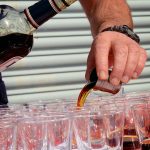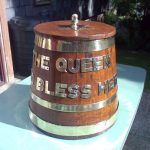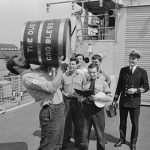 There are some traditions or practices that, upon further consideration, are not necessarily good traditions or practices. Between 1850 and as recently as 1970, sailors on Royal Navy Ships were given a daily rum ration, which was also called a tot, at midday every day. The amount of alcohol it contained was about 1/8 of a pint of rum at 95.5 proof. The practice was discontinued in 1970 because it was thought that regular intakes of alcohol would lead to unsteady hands when working machinery. Senior ratings of petty officer and above received their rum neat, while it was diluted with two parts of water, known a grog, to make 3/8 of an imperial pint for junior ranks. The rum ration was served from one particular barrel, which was ornately decorated and was made of oak and reinforced with brass bands with brass letters saying “The Queen, God Bless Her.” It was known as the “Rum Tub.”
There are some traditions or practices that, upon further consideration, are not necessarily good traditions or practices. Between 1850 and as recently as 1970, sailors on Royal Navy Ships were given a daily rum ration, which was also called a tot, at midday every day. The amount of alcohol it contained was about 1/8 of a pint of rum at 95.5 proof. The practice was discontinued in 1970 because it was thought that regular intakes of alcohol would lead to unsteady hands when working machinery. Senior ratings of petty officer and above received their rum neat, while it was diluted with two parts of water, known a grog, to make 3/8 of an imperial pint for junior ranks. The rum ration was served from one particular barrel, which was ornately decorated and was made of oak and reinforced with brass bands with brass letters saying “The Queen, God Bless Her.” It was known as the “Rum Tub.”
As is normal, there were some sailors who did not drink. So the question became, how would they be compensated. It was decided that these sailors would have a mark by their name of “T” for the Temperance movement. Sailors who opted to be “T” were given three pence, or about $1.00 a day instead of the rum ration. It is said that most of the men preferred the rum. The time when the rum ration was distributed was called “Up Spirits,” which was between 11 am and 12 noon. A common cry from the sailors was “Stand fast the Holy Ghost.” This was in response to the bosun’s call “Up Spirits.” Each mess had a “Rum Bosun” who would collect the rum from the officer responsible for measuring the right number of tots for each mess. The officers did not get a rum ration. Another strange tradition associated with rum rations is that the Tot glasses were kept separate from any other glasses. This was because they were washed on the outside, but never inside, in the belief that residue of past tots would stick to the side of the glass and make the tot even stronger. I would consider that to be really gross, but I’m not a sailor. Sailors under 20 were not permitted a rum ration, and were marked on the ship’s books as “UA” (Under Age).
A sailor’s ration of alcohol was originally beer. At that time, a daily ration of one gallon was given. This official allowance continued until after the Napoleonic Wars. When beer was not available, as often happened due to spoilage, it could be substituted by a pint of wine or half a pint of spirits depending on what was locally available. Later, the political influence of the West Indian planters led to rum being given the preference other spirits. The half pint of spirits was originally issued neat, or without water. It is said that sailors would “prove” its strength by checking that gunpowder doused with rum would still burn (thus verifying that rum was at least 57% ABV). I guess they didn’t trust the bar tender. “The practice of compulsorily diluting rum in the proportion of half a pint to one quart of water (1:4) was first introduced in the 1740s by Admiral Edward Vernon (known as Old Grog, because of his habitual grogram cloak). The ration was also split into two servings, one between 10 am and noon and the other between 4 and 6 pm. In 1756 Navy regulations required adding small quantities of lemon or lime juice to the ration, to prevent scurvy. The rum itself was often procured from distillers in Jamaica, Trinidad and Tobago and the British Virgin Islands. Rations were cut in half in 1823 and again in half, to the traditional amount, in 1850.”
In 1850, Parliament discussed the abolition of the rum ration, then again in 1881, but nothing came of it. In 1970, Admiral Peter Hill-Norton abolished the rum ration as he felt it could have led to sailors failing a breathalyzer test and being less capable to manage complex machinery. This decision to end the rum ration was taken after the Secretary of State for Defense had taken opinions from several ranks of the Navy. Ratings were instead allowed to purchase beer, and the amount allowed was determined, according to the MP David Owen, by the amount of space available for stowing the extra beer in ships. The last rum ration was on July 31,  1970 and became known as Black Tot Day, because sailors were unhappy about the loss of the rum ration. There were reports that sailors threw tots into the sea and the staging of a mock funeral in a training camp. In place of the rum ration, sailors were allowed to buy three one-half imperial pint cans of beer a day and improved recreational facilities. While the rum ration was abolished, the order to “splice the mainbrace,” or awarding sailors an extra tot of rum for good service, remained as a command which could only be given by the Monarch and is still used to recognize good service. Rum rations are also given on special occasions. Examples include the 100th anniversary of the Canadian Royal Navy in 2010 and after the Queen’s Diamond Jubilee celebrations in 2012.
1970 and became known as Black Tot Day, because sailors were unhappy about the loss of the rum ration. There were reports that sailors threw tots into the sea and the staging of a mock funeral in a training camp. In place of the rum ration, sailors were allowed to buy three one-half imperial pint cans of beer a day and improved recreational facilities. While the rum ration was abolished, the order to “splice the mainbrace,” or awarding sailors an extra tot of rum for good service, remained as a command which could only be given by the Monarch and is still used to recognize good service. Rum rations are also given on special occasions. Examples include the 100th anniversary of the Canadian Royal Navy in 2010 and after the Queen’s Diamond Jubilee celebrations in 2012.


Leave a Reply